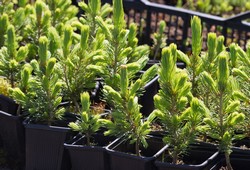Insecticide-free protection for conifer seedlings
Pine weevils are pest insects that cause significant damage to newly planted forests across Europe by feeding on the bark of conifer seedlings. Chemical insecticides currently used for weevil control have environmental and health hazards (and several have recently been restricted), warranting alternative plant protection methods. The EU-funded WEEVIL STOP (Development of a cost-effective and sustainable insecticide-free plant protection method, eliminating widespread catastrophic damage in the forestry caused by the pine weevil Hylobius abietis) initiative aimed to develop a method to protect seedlings by coating them with wax, creating a physical barrier to feeding damage. To achieve this goal, researchers at universities in Norway and Sweden investigated wax-plant interactions and seedling quality after coating them with wax. WEEVIL STOP used an automated process to cover the main stem of conifer seedlings with a precise amount of wax. Researchers found that a thick coating of wax increased protection and was less prone to cracking when the stem expanded with seedling growth. WEEVIL STOP found that plant fitness was reduced if stems were too thickly coated, particularly if the wax covered the shoots. In addition, researchers noted that wax-treated seedlings planted under certain conditions, for example in dark humus – activated sludge, suffered from heat-related problems and in some cases died. The researchers conducted a field trial in the south-western part of Norway to test the wax method in a coast field with rough weather conditions. WEEVIL STOP found a close relationship between the wax height, wax thickness and effective seedling protection from more than a year of trials. Overall, WEEVIL STOP achieved the best results by applying wax to the lower stem portion at a thickness of between 0.6 mm and 1.0 mm. The researchers developed a fully automated machine that can coat seedlings with this specific thickness of wax between the root neck and 10 cm up the stem. Unlike insecticide, which requires repeated applications, seedlings will be coated with wax just once before being planted in the forest, providing protection for two seasons. In addition to economic benefits, this environmentally friendly alternative to chemical insecticides complies with EU directives for clean water, pest management and sustainable forestry.
Keywords
Insecticide, seedlings, pine weevils, plant protection, WEEVIL STOP, wax

